Weed Identification
COMMON GRASS WEEDS
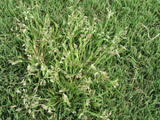 Occurrence:
Occurrence:
Wintergrass seed germinates in autumn. The plants grow actively from late Autumn through to late Spring, seeding throughout Winter and Spring.
Treatment:
Can be treated with a pre-emergent spray throughout Autumn and Winter or post-emergent in Spring.
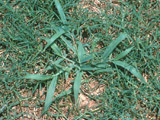 Occurrence:
Occurrence:
An annual weed with fibrous roots and clusters of soft stems which grow close to the ground. Germinates in Spring/Summer.
Treatment:
Can be treated with a pre-emergent spray in Spring before seed germination occurs, and post-emergent in couch species throughout Summer/Autumn.
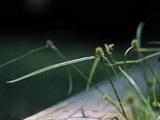 Occurrence:
Occurrence:
Invasive grass growing actively throughout Spring/Summer/Autumn.
Treatment:
Spraying is most effective in warmest months of the year.
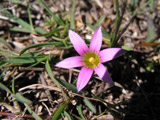 Occurrence:
Occurrence:
Germinates in late Autumn from a brown bulb or small brown seed. Firm, shiny, grass-like leaves grow actively through Winter and it flowers in Spring.
Treatment:
Controlled by spraying when weeds are actively growing, preferably before flowering.
COMMON BROADLEAF WEEDS
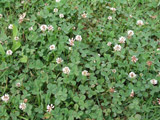 Occurrence:
Occurrence:
A perennial plant with white flowers in Spring which attract bees. The flowers produce seed that can remain viable in the soil for many years.
Treatment:
Controlled by spraying actively growing weeds in Winter/Spring.
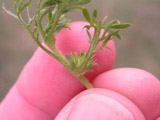 Occurrence:
Occurrence:
An annual weed that establishes from seed in Autumn, grows actively through Winter and flowers in Spring.
Treatment:
Control needs to be timed to prevent seeding in Spring as it produces burrs with sharp spines.
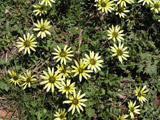 Occurrence:
Occurrence:
An annual weed which establishes from seed in Autumn, grows actively through Winter and flowers in Spring.
Treatment:
Controlled by spraying actively growing weeds.
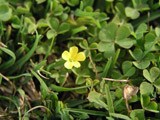 Occurrence:
Occurrence:
A perennial weed that establishes from seed. Very persistent in low cut turf due to the stoloniferous growing habit.
Treatment:
Programme should include a pre-emergent spray plus spraying actively growing weeds.
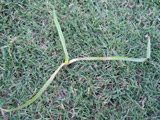 Occurrence:
Occurrence:
An erect annual, biennial or perennial plant up to 30cm high, reproducing from seed or bulb.
Treatment:
Controlled by spraying when weeds are actively growing, preferably before flowering.
 Occurrence:
Occurrence:
A commonly occurring perennial weed that grows from a rosette which produces new leaves and seed heads.
Treatment:
Controlled by spraying actively growing weeds.
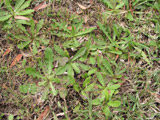 Occurrence:
Occurrence:
Mature plant is semi-erect up to 30cm. Deeply lobed leaves with yellow flowers. Also known as flatweed.
Treatment:
Controlled by spraying actively growing weeds.
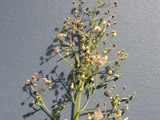 Occurrence:
Occurrence:
An annual weed which, if left untreated, can shoot a seed head to over a metre high.
Treatment:
Controlled by spraying actively growing weeds, preferably before flowering as seed head can become tall and woody.
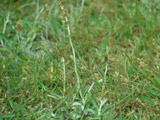 Occurrence:
Occurrence:
Flat, dense weed which can shoot a hairy seed head up to a metre if left untreated. Mature plants can ‘choke’ grass underneath and leave pockmarks or divots in lawn surfaces once removed.
Treatment:
Controlled by spraying actively growing weeds, preferably prior to 4 or 5 leaf stage.
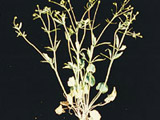 Occurrence:
Occurrence:
Erect, creeping, flowering perennial weed, sometimes referred to as ‘pop’ or ‘flick’ weed as seeds ‘pop’ off flowers when disturbed.
Treatment:
Controlled by spraying actively growing weeds as early in the cool season as possible to avoid seed-set.
 Occurrence:
Occurrence:
A delicate, erect annual weed which protrudes above the lawn canopy.
Treatment:
Controlled by spraying actively growing weeds.
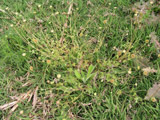 Occurrence:
Occurrence:
Similar in appearance to Bindii; carries no spike-forming flower, just a small yellow-lobed flower on the end of a 40-50mm shoot. Generally forms earlier in the season than Bindii.
Treatment:
Controlled by spraying actively growing weeds.
INSECT PESTS
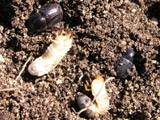
Larvae occur from early Spring to mid-Summer and cause damage to turf roots.
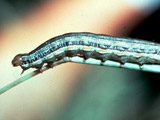
Occurs throughout Summer/Autumn, with humidity favouring development. Feeding damage occurs at night, with brown caterpillars eating the leaf down to the crown of the plant. Very damaging when in large numbers.
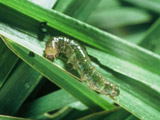 Occurs throughout Summer/Autumn, with humidity favouring development. Feeding damage occurs at night, with lime caterpillars eating the leaf down to the crown of the plant. Very damaging when in large numbers. Soft leaf Buffalo varieties appear most susceptible.
Occurs throughout Summer/Autumn, with humidity favouring development. Feeding damage occurs at night, with lime caterpillars eating the leaf down to the crown of the plant. Very damaging when in large numbers. Soft leaf Buffalo varieties appear most susceptible.
DISEASES
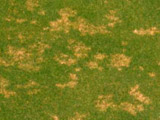 Turf damage:
Turf damage:
Small (4-5cm) circular sunken patches that can join up if left untreated.
Occurrence:
First appears as mycellium (cottony thread). Generally occurs at 15-30 degrees Celsius with high humidity or dew, and low nitrogen levels in turf.
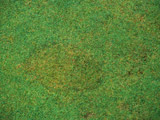 Turf damage:
Turf damage:
Rapid onset of ’smoke ring’ patches within a period of less than a week. Can be from 5cm up to 1m in size.
Occurrence:
Onset is from October through to mid-May with moist, warm conditions favouring development.
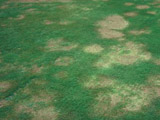 Turf damage:
Turf damage:
Begins as circular spots with a light brown water soaked appearance. Can feel slimy and affect large areas of turf quickly.
Occurrence:
Warm nights (+20 degrees Celsius) and warm days especially with soft growth from nitrogen application.
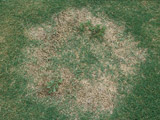 Turf damage:
Turf damage:
Circular patches appear late Autumn/Winter as lawn growth declines. These patches can be 10-15cm across in 1st year, increasing to 15-40cm in subsequent years if left untreated. Patches may get larger than this.
Occurrence:
Late Autumn/Winter, with recovery evident throughout hottest months.
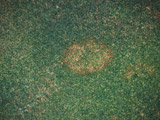 Turf damage:
Turf damage:
A small circular patch with a distinct smoke ring apparent in winter. May show a pink ring with a white centre.
Occurrence:
Prevalent in cool conditions (0-8 degrees Celsius) in turf with high nitrogen levels.
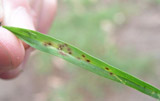 Turf damage:
Turf damage:
Causes reddish-brown to purplish-black spots on leaves and stems which spread quickly. Leads to turf dessication.
Occurrence:
Wet conditions with high humidity between 3-30 degrees Celsius.
